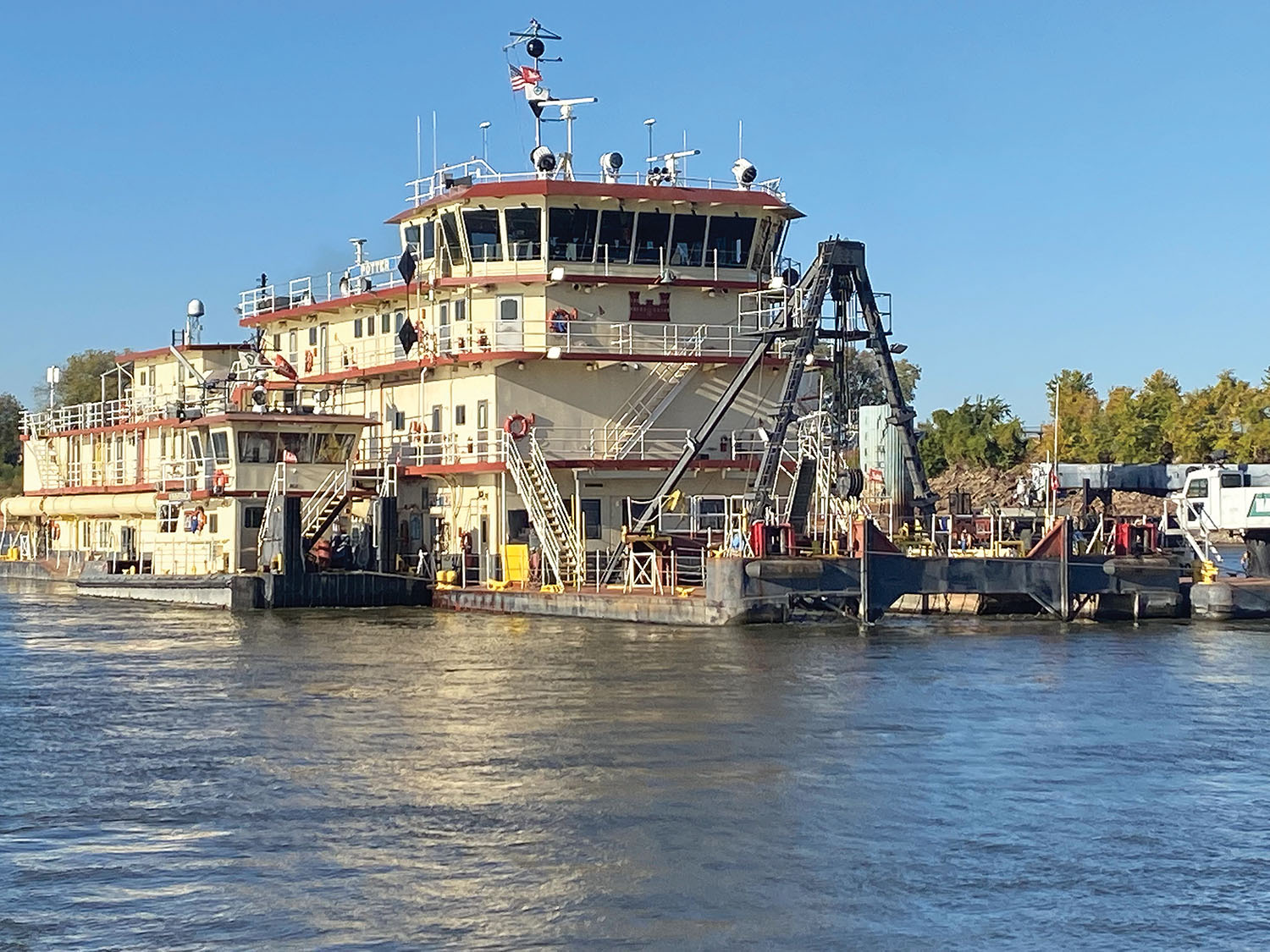After an extended dredging season prolonged by extreme low-water conditions in the fall and extending into the winter, dredging crews in the Memphis, Vicksburg and St. Louis engineer districts have wrapped up their work.
Memphis District
In the Memphis district, the 36-member crew of the dredge Hurley had a record-breaking 273-day season, moving 14.5 million cubic yards of material between April 26 and January 13, when it returned to its home at the Ensley Engineer Yard in Memphis.
A typical season sees the crew working from around May to September, Memphis District Navigation Branch Chief Matt Young said.
Instead, the crew got underway in April, performing maintenance dredging where surveys the previous year had indicated some potentially problematic areas. However, starting about September 24, the Hurley started seeing the effects of low water on the Lower Mississippi.
“Typically, when we dredge it is to maintain the channel or get ahead of it so there are no closures, but with these conditions we became more reactive, from near the end of September to about mid-January,” Young said.
In a typical year, the Hurley dredges 14 to 18 sites. This year an additional 12 sites were added due to low water, and the Hurley, like the Jadwin in the Vicksburg District and the Potter in the St. Louis District, moved where needed throughout the system, from the St. Louis district all the way south to the New Orleans district.
Hurley Capt. Adrian Pirani said the effects of the low water were obvious, beginning with notifications of tows going through shallow water and bumping or rubbing ground.
On October 17, the Mississippi River in Memphis, Tenn., measured at an all-time low of -10.76 feet. By October 20, the Hurley had removed just under 12.7 million cubic yards of sediment. With almost three months to go, this amount surpassed amounts dredged during the 2021-2022 season.
“As time went on, there were people being stuck on ground,” Pirani said. “It got sometimes where there were closures for sometimes a day or two. Some of those tows were 25 or 30 barges, and they had to break them down, one by one sometimes.”
Pirani compared the drought to one in 2012, where the crew dredged longer, but not straight through, having to stop for repairs when needed. Back then, he said, the Hurley only had one pump. Now it uses two main pumps, so it was able to move more material. This year the Hurley stopped its work only once, to deal with the effects of a damaging snowstorm.
While working closely with the Coast Guard to reset buoys and collaboration with committees like the River Industry Action Committee (RIAC) on the Upper Mississippi and the Lower Mississippi River Committee (LOMARC) on the Lower Mississippi was essential, Young said some valuable information also came from mariners reaching out to dredges on the radio after pushing through problem areas.
“It was constant communication,” Young said.
He recalled instances where he had Pirani on the phone with the Coast Guard at 5:30 one morning and then again after 10 that night to plan the next day’s work, only to have to be back on the phone at 5:30 the next morning when river conditions changed, and plans also had to.
“It wasn’t that each dredge stayed in his or her own district,” Young said. “It was which one can get there fastest to that location.”
The furthest north the Hurley traveled to dredge was to Upper Mississippi Mile 113 at Cherokee Landing, 848 river miles north of the southernmost location dredged, at Sardine Point at Lower Mississippi River Mile 219.
Dredging crews typically work two weeks one and one week off, but many were working five weeks on and one week off during the season, and Pirani spent about 90 days on at one stretch.
Lingering effects of COVID-19 and the workforce shortage made doing the work more difficult at times, Pirani said. Crews also had to think ahead and be proactive.
“We’re a little more remote, so it’s a little hard to get phone service to find a mechanic or get parts,” he said.
Young talked about how different people from within the Corps pitched in as needed to get the job done.
“We were borrowing people from other districts,” he said. “There were times we were making surveyors deckhands.”
As the season wore on, the effects of so much dredged sand and gravel had an effect on the equipment as well.
“We’ve got impellers that start about 2 inches in width, and the main pump impeller that we took out this year, you could have shaved with it,” Young said.
He added that the parts are not something that maintenance crews can find at Lowe’s or Home Depot, either.
The Hurley is in a better position than other U.S. inland river dredges, however. While the Potter and the Jadwin were both built in the 1930s, the Hurley was built in 1993. It has already undergone major retrofitting to be more capable for the job, however.
In 2010, the Hurley was lengthened by 50 feet so that instead of having the capability of dredging to 40 feet it can now reach a depth of 80 feet. In 2016, crews added a submersible “booster” pump on the ladder, increasing production between 20 and 30 percent.
This year’s low-water season meant digging deeper than ever before in some spots, Pirani said. It also meant objects that some people had sunk to the river bottom sometimes came back up as the crew had to clean out the ladder after only a few hours. Items that came out of the river included refrigerators, freezers, scrap iron and a few boulders, along with some large trees.
Planning Ahead
Off-season work on the Hurley is scheduled to include repairing the ladder and ladder pump, dustpan, the three main generators, and Z Drives. Ensley Engineer Yard personnel perform much of this specialized work.
The Hurley is already preparing to go back out for the spring 2023 season, and the Memphis district is also planning to repower the Hurley in October 2024, increasing power in the electric-over-diesel dredge from 7 megawatts to about 9.3 megawatts and preparing to implement Tier 4 emission standards, among other work.
“Even while repairs are performed, it’s a regional asset and therefore important that the Hurley remain postured and ready to execute dredging operations, at a minimum within 72 hours, or at any given time should river conditions warrant it,” Young said. “Many thanks to the Operations Division personnel who maintain and support the Dredge Hurley and crew. Their efforts ensure the Hurley crew can safely perform this vital mission, even in high demand times.”
Vicksburg District
The Vicksburg Engineer District’s Dredge Jadwin spent 254 days on the water between May 10, 2022, and January 19. A normal season for the dredge is 160 days, according to the Vicksburg district.
During the season, the 89-year-old Jadwin relocated 6.2 million cubic yards of material from the Mississippi River. Besides working within its home district, the Jadwin also supported the St. Paul, St. Louis, Memphis, New Orleans and Little Rock districts.
“Dredging is an essential mission to ensure safe and reliable navigation for our nation,” Vicksburg Engineer District Commander Col. Christopher Klein said. “We’re incredibly appreciative of the Jadwin crew and their months of dedication and service through the most recent Mississippi River low-water event. They answered the call and are heroes of the waterways.”
First launched in 1933, The Jadwin is a 274-foot, 2,400 hp. dustpan type of dredge capable of dredging as deep as 68 feet.
St. Louis District
The St. Louis Engineer District’s Dredge Potter finished its season February 1, moving 9 million cubic yards of material at 70 locations along 300 miles of the St. Louis District. AIl total, seven dredging units, dustpan cutterhead and mechanical, were working throughout the district’s area of responsibility. Two other dredges supported the Mississippi Valley Division’s efforts on the Mississippi River.
An average year includes 3 to 4 million cubic yards of material being moved by two dredges, the district said.
In anticipation of the drought, the St. Louis District Dredging Program Manager, Lance Engle, implemented advanced measures—bringing in additional assets ahead of the forecasted lows—to maintain the congressionally authorized channel. Managers closely monitored surveys and reviewed them in conjunction with the forecast, also gaining input from industry to determine the order and coordination of work and additional assets needed.
For reference, it would take more than 2,700 Olympic-size swimming pools to contain the 9 million cubic yards of dredge material removed from the river bed this year, compared with just 1,000 Olympic-size swimming pools in a normal season, the district said.
The St. Louis gage declined from a level of +29.77 feet on May 7, 2022, to -3.87 feet on December 25, 2022.
Meanwhile, the St. Louis District’s water control office worked behind the scenes to continuously monitor river levels and make gate adjustments on the district’s reservoirs and dams. Water managers collected water data while monitoring numerous hydrological and meteorological factors to forecast river conditions. Strategic measures were taken when the river dropped to its lowest level, releasing water from the Melvin Price Dam to allow for additional water to avoid dropping to -6.8 feet.
“As we continue to get more rain and snowmelt season begins, the USACE Water Control division will continue to monitor river stages to provide a safe and reliable navigation channel,” said Joan Stemler, chief of Water Control Operations. “When we experience historic lows or seasonal highs, it’s always a challenge to keep commerce moving, but by constant communication, collaboration and commitment, we can increase preparedness and anticipate what conditions might arise in the future.”
Lou Dell’Orco, chief of operations and readiness for the St. Louis district, expressed pride in the 53-member crew of the Potter.
“Advanced measures taken by the Dredging Product Delivery Team, dredges provided by sister districts, strategic management of low water conditions and the common operating picture that was maintained by the Corps, U.S. Coast Guard Sector Upper Mississippi River, the River Industry Action Committee and local partners resulted in maintaining the nine-foot shipping channel during extreme low water,” he said. “Above all, the master and crew of the Dredge Potter excelled in the delivery of the dredging mission. Their passion and pride in operating and maintaining the 90-year-old vessel was critical to the success of the mission. The next steps in the process are to conduct off-season maintenance on the Dredge Potter and document lessons learned and best practices from this event to refine and improve future actions related to low water.”
Caption for top photo: The St. Louis Engineer District’s Dredge Potter, assisted by the Kimmswick, worked 24/7 through the 2022-23 dredging season on the Mississippi River. The Potter, built in 1932, is a dustpan dredge. The Kimmswick, commissioned in 2006, assists the dredge with pipeline movements. (photo by Janet Meredith/St. Louis Engineer District)




